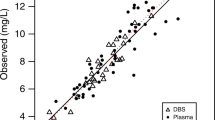Summary
The effect of hypothermia on the disposition of fentanyl was evaluated in 18 children undergoing corrective cardiac surgery. They received a bolus of fentanyl followed by a continuous infusion which was stopped when cardiopulmonary bypass was established and profound hypothermia was achieved (18 °C–25 °C). Fentanyl plasma concentration remained essentially unchanged during hypothermia (6.45 ng/ml 5 min into hypothermia and 5.26 ng/ml 100–140 min later; p>0.1).
In subsequent experiments, the effect of hypothermia on the pharmacokinetics of fentanyl was studied in 4 piglets serving as their own controls. Both distribution volume (Vz) and total body clearance (CL) were significantly smaller during hypothermia. Our studies indicate that being a drug with a large distribution volume and a high hepatic extraction ratio, both CL and Vz are significantly reduced by hypothermia-induced hypoperfusion. In addition, TBC is influenced by the temperature-dependent hepatic metabolism of fentanyl.
Similar content being viewed by others
References
Blair E (1964) Clinical hypothermia. McGraw Hill, New York
Bovill JG, Sebel PS (1980) Pharmacokinetics of high-dose fentanyl. Br J Anesth 52: 795–801
Conn AW, Edmonds JF, Barker GA (1979) Cerebral resuscitation in near drowning. Pediatr Clin North Amer 26: 691–701
Gillespie TJ, Gandolfi AJ, Maiorino RM, Vaughan RW (1981) Gas chromatographic determination of fentanyl and its analogues in human plasma. J Analyt Toxicol 5: 133–137
Goldfrank L (1982) Toxic emergencies. Appleton-Century-Crofts, New York
Goor DA, Mohr R, Lavee J (1982) Enhanced protection of myocardial function by systemic deep hypothermia during cardioplegic arrest in multiple coronary bypass grafting. J Thorac Cardiovasc Surg 84: 237–242
Ham J, Miller RD, Benet LZ et al. (1978) Pharmacokinetics and pharmacodynamics of D-tubocurarine during hypothermia in the cat. Anesthesiology 49: 324–329
Kalser SC, Kelvington EJ, Randolph MM et al. (1965) Drug metabolites in hypothermia. I. Biliary excretion of C14-atropine metabolites in the intact and nephrectomized rat. J Pharmacol Exp Ther 147: 252–259
Kalser SC, Kelvington EJ, Randolph MM et al. (1968) Drug metabolism in hypothermia. Uptake, metabolism, and excretion of S35-sulfanilamide by the isolated, perfused rat liver. J Pharmacol Exp Ther 159: 389–398
Koren G, Crean P, Klein J, Goresky G, Villamater J, MacLeod SM (1984) Sequestration of fentanyl by the cardiopulmonary bypass. Eur J Clin Pharmacol 27: 51–56
Koren G, Goresky G, Crean P, Klein J, MacLeod SM (1984) Pediatric fentanyl dosing based on pharmacokinetics during cardiac surgery. Anesth Analg 63: 577–582
Koren G, Barker C, Bohn D, Kent G, Biggar D (1985) Influence of hypothermia on the pharmacokinetics of gentamicin and theophylline in piglets. Crit Care Med
Koska AJ, Romagnol A, Kramer WG (1981) Effect of cardiopulmonary bypass on fentanyl distribution and elimination. Clin Pharmacol Ther 29: 100–105
Nies AS, Shand DG, Wilkinson GR (1983) Altered hepatic blood flow and drug disposition. In: Gibaldi M, Prescott L (eds) Handbook of clinical pharmacokinetics. ADIS Health Science Press, Section I, pp 75–96
Ohmura A, Wong KC, Westenkow DR, Shaw CL (1979) Effects of hypocarbia and normocarbia on cardiovascular dynamics and regional circulation in the hypothermic dog. Anesthesiology 50: 293–298
Sprigge JS, Wynands JE, Whalley DG, Bevan Dr, Towsend GE, Nathan H, Patel YC, Srikant CB (1982) Fentanyl infusion anesthesia for aortocoronary bypass surgery: Plasma levels and hemodynamic response. Anesth Analg 61: 972–978
Wong KC (1983) Physiology and pharmacology of hypothermia. West J Med 138: 227–232
Author information
Authors and Affiliations
Additional information
Dr. Koren is a Career Scientist of the Ontario Ministry of Health
Rights and permissions
About this article
Cite this article
Koren, G., Barker, C., Goresky, G. et al. The influence of hypothermia on the disposition of fentanyl — Human and animal studies. Eur J Clin Pharmacol 32, 373–376 (1987). https://doi.org/10.1007/BF00543972
Received:
Accepted:
Issue Date:
DOI: https://doi.org/10.1007/BF00543972




